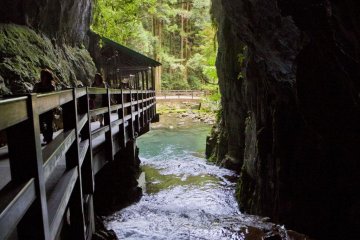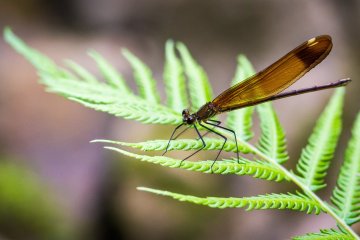
Akiyoshidō Cave, an Exploration
Jerome LeeAkiyoshido Caves is the largest limestone cave in Japan, part of Akiyoshidai, the largest karst plateau located in the city of Mine in Yamaguchi Prefecture.
Akiyoshido Cave (秋芳洞) is Japan's longest and largest limestone cave.
Best visited by car, but accessible by bus.
The pedestrian thoroughfare that connects the entrance of Akiyoshi Cave to restaurants, shopping, parking and the bus center is a 40-minute bus ride (1,170 yen, 1 per hour) from the Shin-Yamaguchi Shinkansen station or a 60-minute bus ride (1,210 yen, 1 per 2 hours) from Yamaguchi Station, both in Yamaguchi City.
From Mine Station, it’s a 25-minute bus ride (200 yen, 1 every 90 minutes). There's also a "Karst Taxi" service for transport in and around the park.

Akiyoshido Caves is the largest limestone cave in Japan, part of Akiyoshidai, the largest karst plateau located in the city of Mine in Yamaguchi Prefecture.

Akiyoshi Cave is a mangificent adventure through Japan's (literal) underground

Mine City, in Yamaguchi Prefecture, is gearing up to launch new caving experiences at its famed Akiyoshido cave system — the largest limestone cave network in Japan. The cave and nearby Akiyoshidai plateau—collectively forming a Quasi-National Park and Geopark—together represent some of the brightest jewels in Yamaguchi’s tourism crown, providing an other-worldly landscape that is unique to Yamaguchi and has long captivated visitors to this part of western Japan. Akiyoshidai’s karst landscape: 300 million years of evolution Akiyoshidai’s unique geology and karst landscape can be traced back to over 300 million years when this region was submerged underneath the ocean and home to a vast coral reef. The effects of erosion from rainfall and magmatic shifts over time helped give rise to both karst pinnacles above ground and, along with above-ground hollows (called ‘Doline’) formed by erosion, the development of limestone caves further below. [photo id='237910'] These underground caves at Akiyoshido—Japan’s largest and longest limestone cave network—are now a designated Special Natural Monument whose iconic entrance lies in a cedar grove on the southern side of Akiyoshidai. Inside, visitors can typically follow a leisurely 1-km sightseeing course that is paved and well-lit. Along the way, you can enjoy the cave’s many unique and mysterious formations, like giant stalagmites and a large rice terrace-like rimstone area inside the main cavern. [photo id='237911'] A naturally constant 17°C inside the cave keeps conditions relatively mild during the summer and relatively warm during the winter season. New Caving Routes at Akiyoshido Mine Tourism Association is hoping to appeal to adventure travellers and entice those looking for a more authentic, rare experience by taking them—literally—off the beaten path. [photo id='237912'] From summer 2024, they’ll start to accept bookings for group tours of vast new caving routes that have never been opened to the public before (and are said to be the largest of their kind to be made accessible like this). [photo id='237913'] Under the supervision of an expert guide, groups of up to 6 people will be able to traverse the underground rocky caverns and streams along one of several courses expected to last 2–4 hours. [photo id='237909'] Expect to find new underground lakes that shine cobalt blue when illuminated, or a chance to witness a wind tunnel (kaze-ana) that connects the surface down through to the main Shumisen cavern. [photo id='237908'] Compared to nature above ground, caving gives us—alongside a dose of adrenaline—a unique chance to connect closer to Mother Earth and offers a symbolic, visible link to the Earth’s past. [photo id='237914'] It is moving to think millions of years of geological evolution can be witnessed up close right before our very eyes, in an environment with zero natural light and unique fauna that feels more out of sci-fi than anything else (the lack of smartphone signal too—yes, consider this a great digital detox even if for just a few hours). [photo id='237915'] Overall, a chance to explore these new corners of Akiyoshido should appeal to many kinds of visitors and some of the routes are expected to be beginner-friendly too. Make Mine City Yours: New Geo Tours to Connect with Nature The caving experiences will tie into local tours that better reflect what Mine City has to offer. Above ground, an introduction to the wider Akiyoshidai region will be provided by trained, local Geo-guides from the Mine Akiyoshidai Geopark Centre at Karstar. They will walk you along accessible parts of the plateau while explaining about the region’s history as well as local conservation efforts to protect animals and plants, like the annual controlled yama-yaki burning that helps protect the grassland from overgrowth. [photo id='237916'] Historically, the plateau’s grass was vital for the livelihood of local people, from providing feed for farm animals, to acting as a fertiliser for growing vegetables. The yama-yaki ritual, therefore, helped stop trees form and is a tradition that continues to this day. This link to the area’s food culture can also be experienced by tour participants, with dishes including local specialities to be made available, like Mito burdock root, Akiyoshidai Plateau Beef and Shuho pear. [photo id='237917'] Caving aside, these tours are likely to offer a deeper experience of getting to know and understand this part of Yamaguchi on a whole new level. Around Mine and Yamaguchi Besides Akiyoshidai Plateau, Mine City has a few more sightseeing spots worthy of note, like the cobalt blue waters at Beppu Benten Pond, trout fishing at the Fish Farm and family-friendly Akiyoshidai Safari Land. Several camping facilities within the Akiyoshidai Plateau area can also provide a unique way to spend more time in the area and a chance to witness the region’s starry skies. Further afield, Mine is perfectly placed to continue your Yamaguchi adventure by visiting neighbouring regions like Hagi (50 min by car, famous for pottery), Nagato (50 min by car, famous for the red torii gate tunnel at Motonosumi Shrine) and Tsunoshima Island (50 min by car, known for its turquoise waters and sandy beaches). You’re also not too far from the prefecture’s other big attractions: 30 min by car from Yamaguchi City (named by The New York Times as a 2024 Travel Destination, known for Yuda Onsen and Rurikoji temple*) as well as 90 min by car from Iwakuni’s magnificent Kintaikyo Bridge. *The temple’s pagoda is under renovation until 2025 but will remain partially visible behind clear acrylic panels being installed on its eastern side.

Most visitors to Akiyoshidai Quasi-National Park come for the otherworld panoramas and underground adventures in this geologically fascinating karst landscape—but the park is also full of life.

Go back in time with an imaginative visit to Japan's largest karst topography with its green moonscape views and hundreds of ancient caves.

Akiyoshidai Quasi-National Park is a nature lover's paradise. Founded in 1955, it is home to Japan's largest limestone plateau and Japan's largest cave.